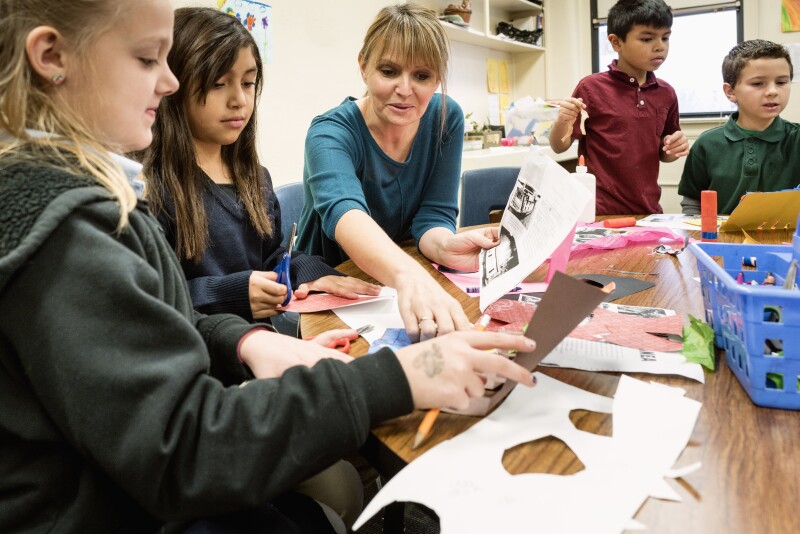Whether you’re a person who’s 22 or 92, it’s likely your memories of school are remarkably similar: classrooms, desks, a teacher in front at the board, textbooks, libraries. Although the world has changed drastically in the last 75 years, educational methods haven’t always followed suit. Too many children in too many schools continue to engage in too much rote learning, says Ted Dintersmith, a venture capitalist known for his work on the intersection of innovation and learning.
In his latest book, “What School Could Be: Insights and Inspiration from Teachers Across America,” Dintersmith shares observations from a yearlong trek to all 50 states, stopping in schools of all sizes, types and philosophies to hear educators discuss what works best, and how innovation happens in the process.
While Dintersmith, an honors graduate of William & Mary who holds a Ph.D in engineering from Stanford, has no formal training in pedagogy, over the past decade he’s become an advocate for education policies that foster creativity, innovation, motivation and purpose. In his earlier book, “Most Likely to Succeed,” Dintersmith focused on how we should prepare our youth for what he calls the “Innovation Era.”
“I think in 10 years there will be essentially no jobs left in the economy that don’t require some special skill by the employee hoping to fill that role,” Dintersmith said in an interview. “This is a fact: If it involves pattern recognition or following instructions, or if it’s something you can write a tight job description around, it’s probably going to be done by machine intelligence. If all you’re good at is memorizing content, replicating low-level procedures and following instructions, you will not be getting a job.”
For anyone who grew up in the age of classrooms with desks and boards on the wall, that’s an unsettling notion. Many of us were trained to work toward high exam scores and seek admission into the best-possible colleges and universities. But Dintersmith cautions that this kind of thinking doesn’t necessarily foster the creativity needed in a time when automation and artificial intelligence (AI) are developing quickly.
Studying Subject Matter Mavericks
But unlike Bill Gates, who has put his monetary heft and cultural influence behind top-down educational reform initiatives like Common Core, Dintersmith decided to go to ground and watch teachers. After all, it’s teachers who are the true subject matter experts when it comes to how our children learn.
One of the most fascinating aspects of “What Schools Could Be” lies in its author’s encounters with maverick faculty and administrators who empower each other and their students to approach learning in ways that are anything but systemic.
A Connecticut administrator, for example, wants to help kids “create portfolios of joy” instead of toiling to memorize minutiae for AP exams. Second-grade classrooms in Sitka, Alaska, use “Minecraft”—yes, the video game—to design experiences and stay engaged. A high school English teacher in North Dakota instituted a “Genius Hour” each week in which students are allowed to work on whatever interests them. In several states, community-led programs work with schools and students to foster the kinds of learning you can’t get within the confines of a workbook, like making skateboards in Michigan or encouraging Kansan kids to get outside in the natural world. In all of his examples, even the ones in schools facing the toughest challenges, Dintersmith notices the most success in situations where educators listen less to outside influences and instead focus on what works for the students who depend on them.
As a result of spending day after day with teachers doing extraordinary things, Dintersmith developed an approach to learning he calls “PEAK:”
Purpose: Students believe in the importance of their work.
Essential Skills and Mindsets: Learning experiences foster competencies that are essential to adults (e.g., creative problem solving, critical analysis, communication, collaboration, citizenship, character).
Agency: Students create their learning experiences, set their goals, manage their progress and evaluate their work.
Deep, Retained Knowledge: Students develop real mastery of the topics they study. They can apply it, ask thoughtful questions about it and teach others.
Community-Wide Learning Curve
Dintersmith’s rallying cry is “Our children should study what’s important to learn, not what’s easy for you to test.” What’s important to learn changes faster today than it ever has, so Dintersmith wants us to consider priorities. Is it more useful for young people to memorize state capitals, or to understand why our country is created out of states and not provinces? Should we spend time and money teaching the Palmer Method, or teaching our kids the best methods of communication? Yes, some of his questions may be loaded, but he’s asking instead of dictating, a much different approach than those that have been tried in the past 40-50 years.

He’s also asking communities to get involved—not just parents, whose plates are often overfull. What kinds of schools, classrooms and teaching methods make the most sense for a particular place? Should all members of a community be funneled into degree programs when some might benefit from certificates, apprenticeships or other kinds of further education? What are the needs and weaknesses and strengths of the region?
No one wants to see privilege concentrated in just a few areas, but no one wants to see opportunities lost due to lackluster instruction, either. Assuming Dintersmith is on to something here, his “What Schools Could Be” approach could help your community ask the very questions that turn your school lights from dim to illuminating.


